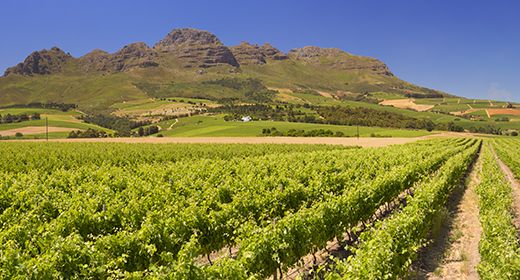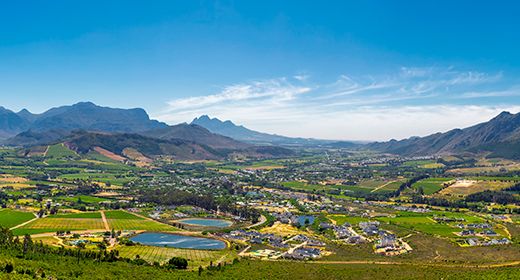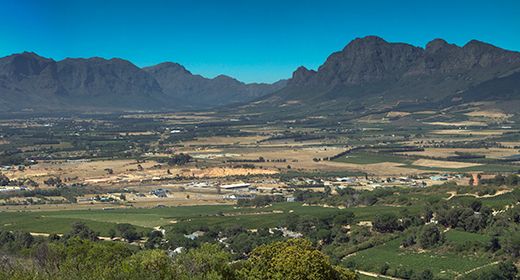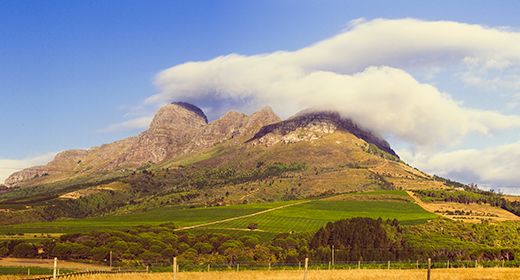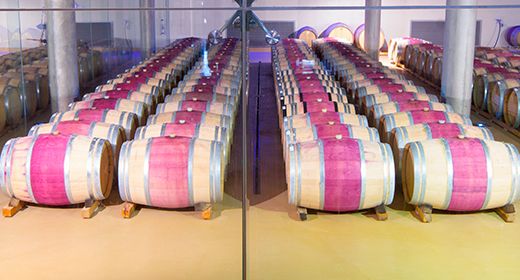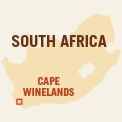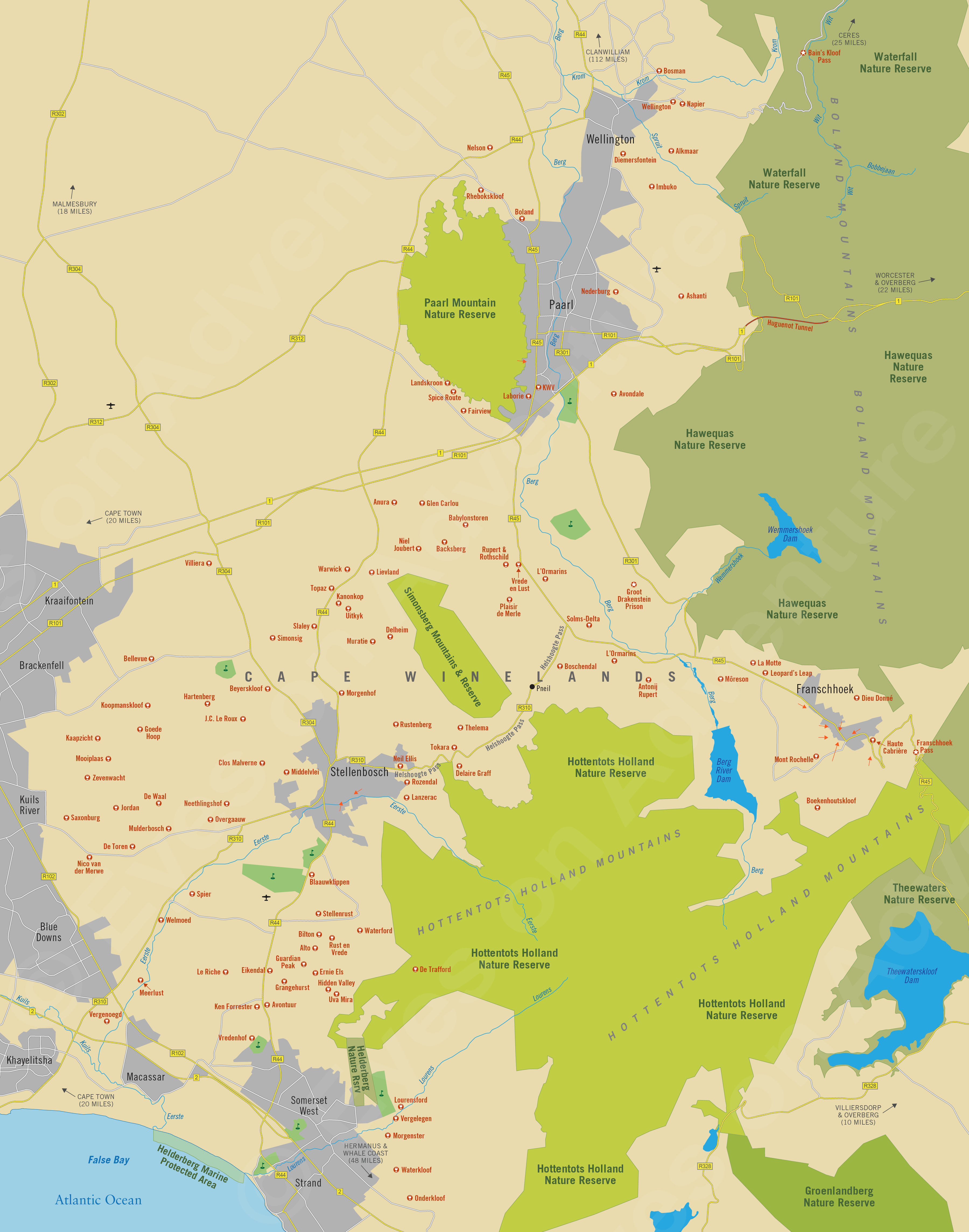Cape Winelands
(incl. Stellenbosch, Franschhoek, Paarl, Wellington, Simonsberg)
Region Links: Cape Peninsula, Cape Town, Cape West Coast, Cape Winelands, Eastern Cape, Garden Route, Gauteng Province, Johannesburg, Kruger Park & Lowveld, Kruger Private Reserves, KwaZulu-Natal, Madikwe, Overberg & Whale Coast, Pilanesberg & Sun City, Sabi Sand Reserve
Highlights
- Experience 300-year-old wine estates and taste their world-class wines
- Dine at some of South Africa's top-rated restaurants
- Visit Stellenbosch, Franschhoek, and Paarl and learn how they shaped South Africa's history
- Explore the spectacular valleys and mountains that make this region so special
EOA Recommends: Delicious Hotel, Grande Roche Hotel, La Residence Franschhoek, Le Quartier Francais, Spier Hotel & Winery, The Last Word Franschhoek
South Africa’s Cape Winelands are one of its brightest gems. Three-hundred-year-old wineries and vineyards sit in magical valleys surrounded by spectacular mountains.
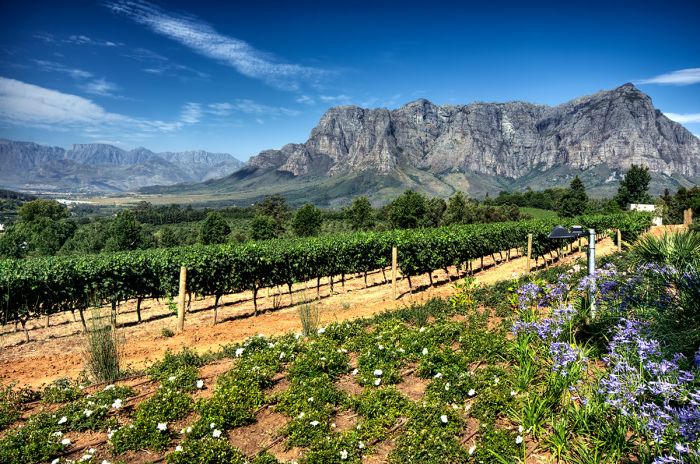
Vineyard in the Stellenbosch region with the Simonsberg Mountain in the distance
Visit the Winelands on a day tour from Cape Town or stay a week and sample the delicious food and wines, but don’t miss this scenic and wonderful region!
The Cape Winelands (also called the Boland, meaning ‘upland’) are located only a 45-minute drive from Cape Town and day trips are easy and popular, but most visitors choose to stay for at least a few days.
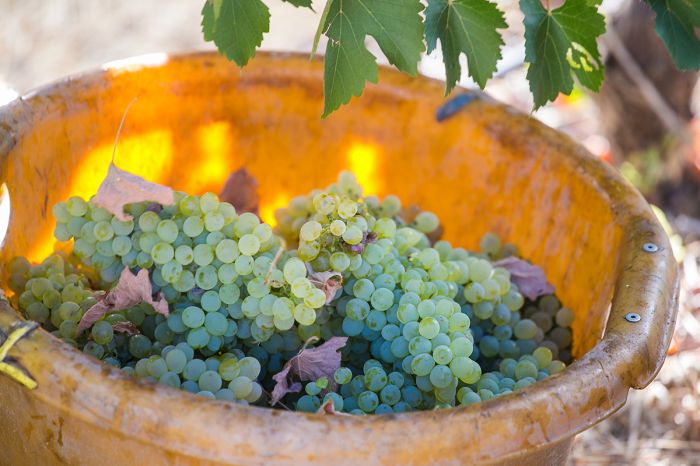
Freshly harvested wine grapes in the Cape Winelands region
The area is home to a multitude of wineries and homesteads, many established in the 1600s and still owned by the descendants of the original families. Besides the excellent wines, the region boasts some of the country’s top restaurants, plentiful boutique hotels, and historic architecture.
The main municipalities in the Winelands are Stellenbosch, South Africa’s second-oldest town, Franschhoek (meaning ‘French corner’), and Paarl (meaning ‘Pearl’). All three date back to the 17th century and each offers its own well-developed wine route.
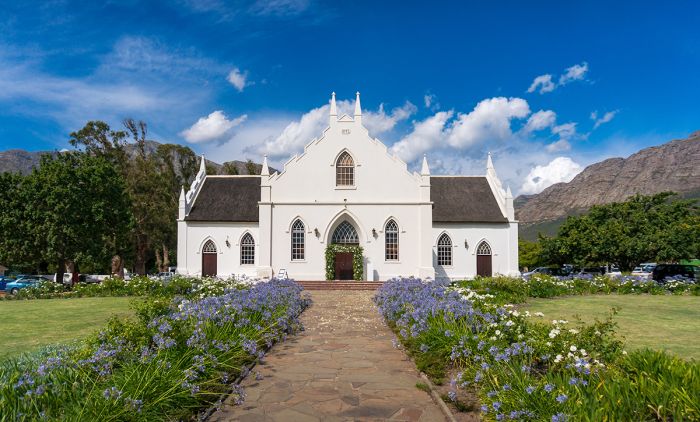
The Dutch Reformed Church in Franschhoek, built in 1847
The best way to see the region is to rent a car in Cape Town and self-drive. The roads are of good quality and the routes and wineries are well-marked. The secret in the Winelands is to take your time and immerse yourself in its bounty, but be careful, you may not want to leave!
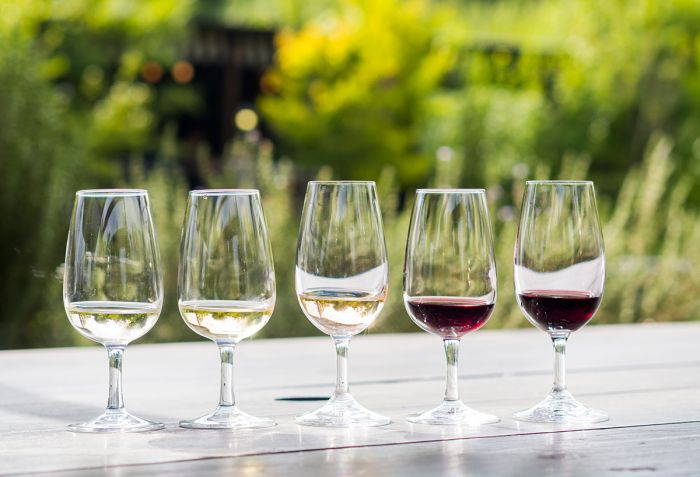
A wine tasting in Stellenbosch
Read More...
Cape Winelands, Franschhoek, Helshoogte Pass, Paarl, South African Wines, Stellenbosch, Wellington, Wineries-Franschhoek, Wineries-Paarl, Wineries-Stellenbosch
Cape Winelands
The Winelands region covered here focuses on the traditional wine centers of Stellenbosch, Franschhoek, and Paarl/Wellington, but the entire Cape Winelands now cover such a vast area, that these long-established locales only account for one-third of the total land under vine in the Western Cape.
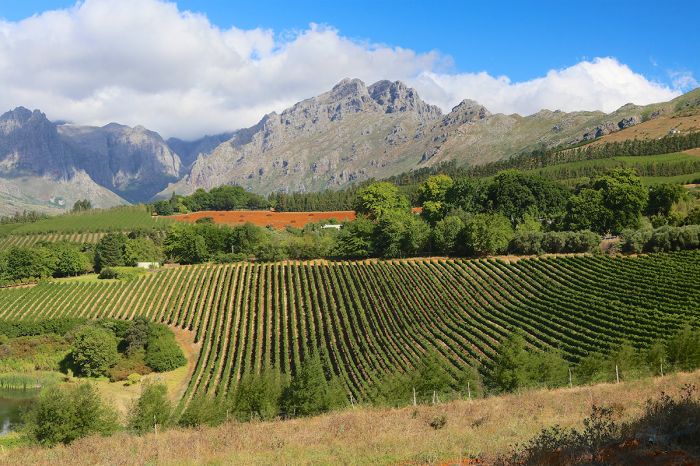
Vineyard and mountain scenery in the Cape Winelands
Stellenbosch and Franschhoek are the most visited of the wine destinations in South Africa. Colonial communities have existed here since the latter half of the 17th century, when Dutch settlers arrived in Stellenbosch and the French Huguenots founded Franschhoek. Accordingly, most of the historic, centuries-old wine estates are centered in these two valleys. Both are surrounded by magnificent mountain ranges, providing near-perfect micro-climates for grape production.
Besides the superb wines, this region, and especially Franschhoek, has become well-known for its fine dining, with a multitude of innovative chefs now based at wine estates and restaurants offering South African cuisine.
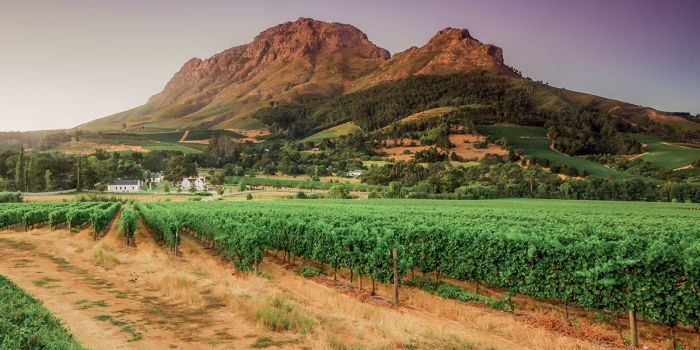
Vineyard and the Helderberg Mountains in the Stellenbosch region
Visiting the Winelands is easy from Cape Town and day tours are available from various operators. If time permits, we recommend adding a few days to your itinerary to explore and enjoy the region. Its best to rent a vehicle in Cape Town and self drive (45 minutes to Stellenbosch, 1 hour to Franschhoek). Even if you don't drink wine, the region is spectacularly beautiful and worth a visit.
Stellenbosch
Stellenbosch was founded in 1679 on the north bank of the Eersterivier (First River) by Simon van Der Stel, the first Governor of the Dutch Cape Colony, and is the second-oldest town in South Africa (after Cape Town). It is a beautiful municipality and still retains a lot of its original feel after more than three centuries.
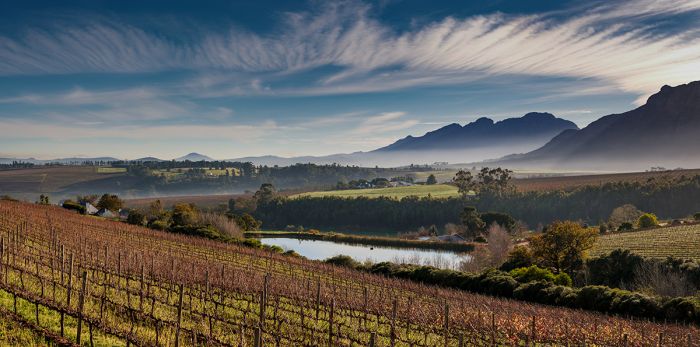
Sunrise over Stellenbosch vineyards
Stellenbosch is considered the urban center and the heart of South Africa's most important wine-growing region. Many of the country's oldest wine estates are scattered around the outskirts of the town and the produce superb wines. The Stellenbosch wine route is also the largest and oldest in the country.
Complimenting the world-class wines produced here are numerous restaurants and nearly every winery has its own restaurant and/or offers pre-booked picnics. Some of the estate restaurants are included in the top ten best in the country and reservations are required well in advance to get a table, especially during the summer.
The Stellenbosch town center is called 'Eikestad' (town of oaks) and there are 300-year-old oak trees lining the original avenues that have wonderfully preserved examples of Cape Dutch and Victorian architecture.
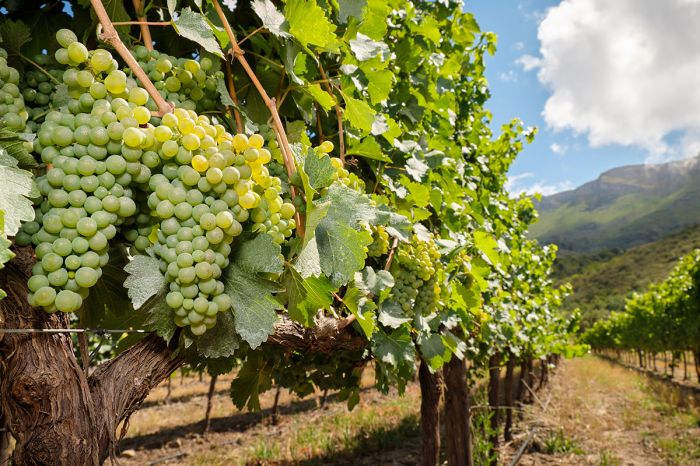
Wine on the vine in Stellenbosch
Home to the Afrikaans-speaking University of Stellenbosch, the town offers more urban attractions than either Franschhoek or Paarl, with a lively pub, restaurant and nightlife scene. There are also some good contemporary restaurants, sidewalk cafés and shops.
The annual Stellenbosch Wine Festival takes place in late February when dozens of local wines are available for sampling all in one place. Wine talks and live entertainment enhance this popular event.
Accommodations can be difficult to get if not booked ahead of time, particularly in summer. Many of the wine estates in the surrounding region also offer guest houses or boutique hotel lodging.
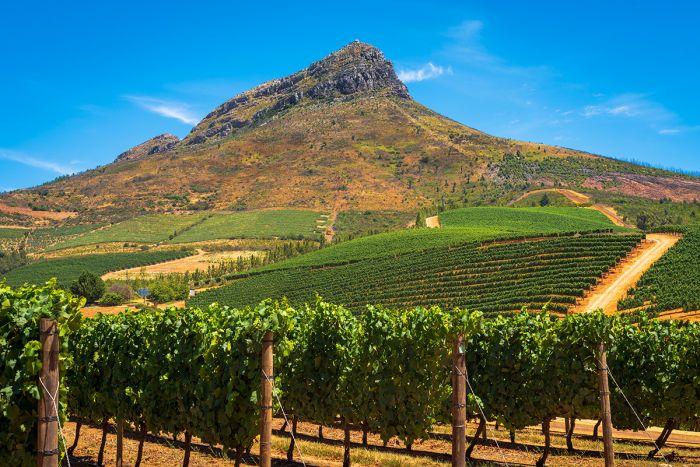
Stellenbosch vineyards with mountain backdrop
Our Winery Picks - Stellenbosch
- Blaauwklippen: A rustic 300-year-old estate with historic buildings. Superb reds, lunches. Sunday market.
- Delaire Graff: Lovely hotel and spa with great views. Outstanding whites, great red blend. Known as the 'vineyard in the sky.'
- Hartenberg: Known for superb reds. Gourmet picnics (Oct-Apr) or light lunches (year-round). Kid friendly.
- Jordan: Modern, high-tech cellar and tasting room with friendly service. Great wines and a highly-rated restaurant too.
- Kanonkop: One of the oldest estates with renowned reds, including the legendary Paul Sauer, and a lavish art gallery.
- Meerlust: Celebrated estate in the same family for eight generations; declared a national monument in 1987. Fabulous reds and a chardonnay.
- Morgenhof: French-owned chateau on the slopes of the Simonsberg mountains. Excellent wines and delicious lunches served.
- Morgenster: Beautiful, rustic setting. Producing two excellent reds, but better known for its olive groves and award-winning olive oils.
- Mulderbosch: Much of the land set aside for indigenous wildlife and vegetation. Family-friendly tasting room and restaurant.
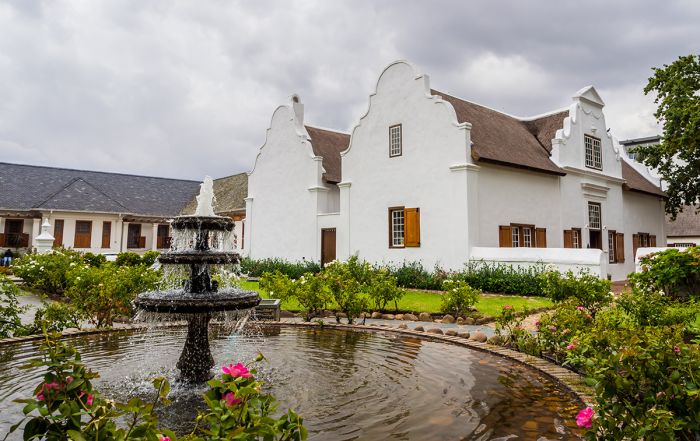
Cape Dutch architecture in the Stellenbosch Winelands
Our Winery Picks - Stellenbosch (continued)
- Muratie: Dates back to early 1700s. Small estate with excellent, earthy reds, including pinot noirs. Port and dessert wines.
- Neethlingshof: Gorgeous setting with a Cape Dutch manor from 1814. First vines planted in 1692.
- Overgaauw: A stylish Victorian tasting room, First estate in South Africa to make a merlot.
- Rustenberg: Beautiful tasting room set in the former stables. Superb wines.
- Rust en Vrede: Spectacular mountain setting with giant oaks, steep vineyards and rose gardens. Consistently produces some of the best reds in the country
- Simonsig: Outdoor tasting area with stunning views. First in SA to produce sparking wine.
- Spier: Diverse activities including Eagle Encounters, Segway tours, three restaurants and special events in summer.
- Tokara: Lovely views, superb restaurant and superb chardonnay and sauvignon blanc.
- Vergelegen: One of the oldest estates. Beautiful setting and views. Garden and cellar tours. Superb wines.
- Vergenoegd: Great for kids, domesticated ducks on premises. Make your own wine or olive oil. Picnics, Sunday market.
- Villiera: Excellent sparking wine. Wildlife drives (antelopes, giraffes, birds) must be pre-booked.
- Warwick: Legendary winery with outstanding reds. Vineyard tours and picnics (book in advance).
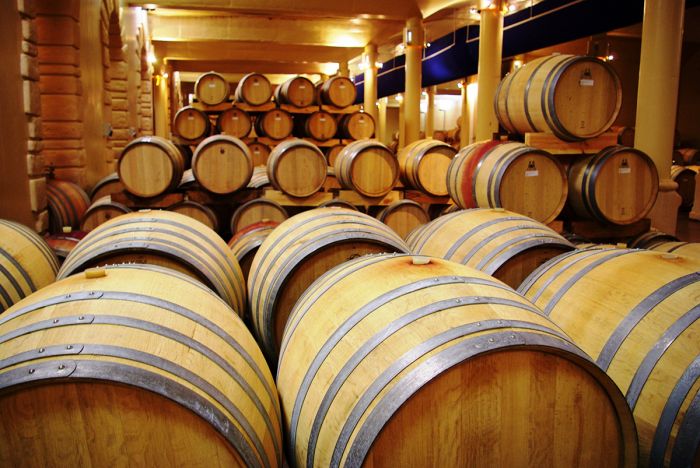
Wine aging in barrels - Stellenbosch Winelands
Franschhoek
The Franschhoek Valley, surrounded on three sides by dramatic mountains, is undoubtedly the most beautiful setting in the Winelands.
French Huguenot refugees, fleeing from persecution by the Catholics in France, began arriving and starting farms in the valley in 1688. By the year 1700, over 200 French settlers were living here, with land deeds granted to them by the Dutch East India Company in Cape Town. These early farmers brought with them grape vines and knowledge of viticulture from France and thus started the wine-making culture in South Africa.
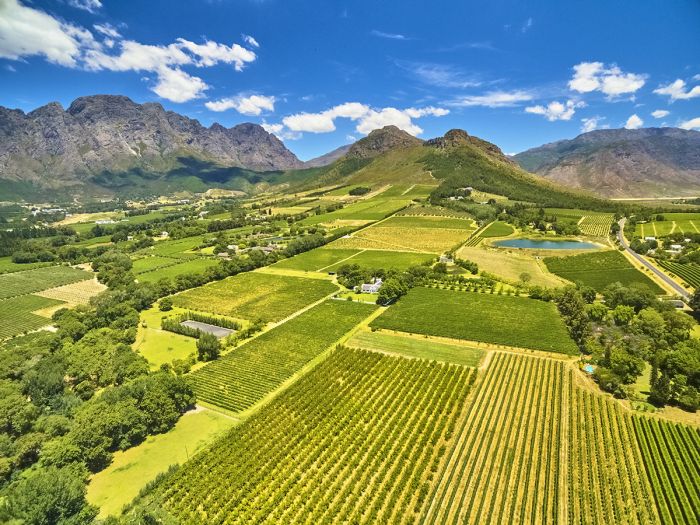
Franschhoek Valley vineyards and surrounding mountains
The French farmers began the practice of naming their homesteads after the regions in France from which the emigrated, such as La Motte, Cabrière, and La Dauphine. The name of the area soon changed to "le Coin Français" (French for 'the French Corner') and later to the Dutch translation, Franschhoek.
The surnames of these early settlers, such as De Villiers, Du Toit, Du Plessis, Joubert, Malan, Marais and others, are still prominent in the many thousands of their descendants living in the region today.
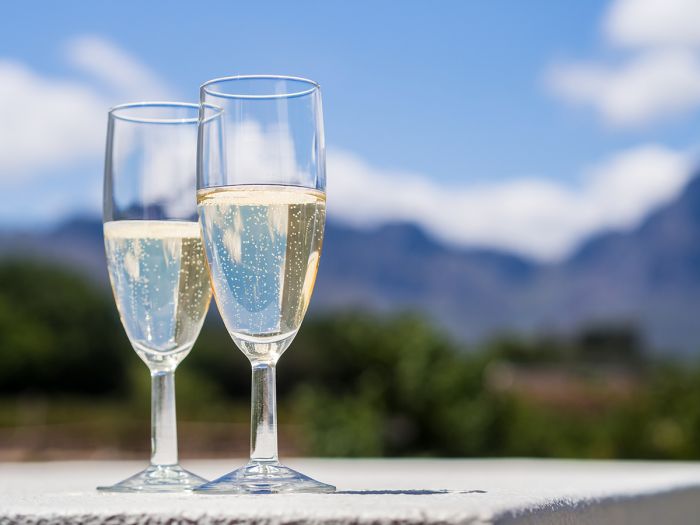
Sparkling wine tasting in the Franschhoek Valley
As lovely as Franschhoek is today, one can only imagine what it looked like in the 17th century, when wildlife roamed freely in the valley, including herds of elephants that moved in and out via the Franschhoek Mountains. Leopards are still resident high in the surrounding peaks, but most of the animals are long gone.
Prior to 1990, Franschhoek was a quiet little countryside retreat, but with the end of Apartheid, the community experienced a major boom with the relaxation of wine sanctions and increased tourism to South Africa. International interest in South Africa's world-class wines grew quickly and property prices in Franschhoek skyrocketed.
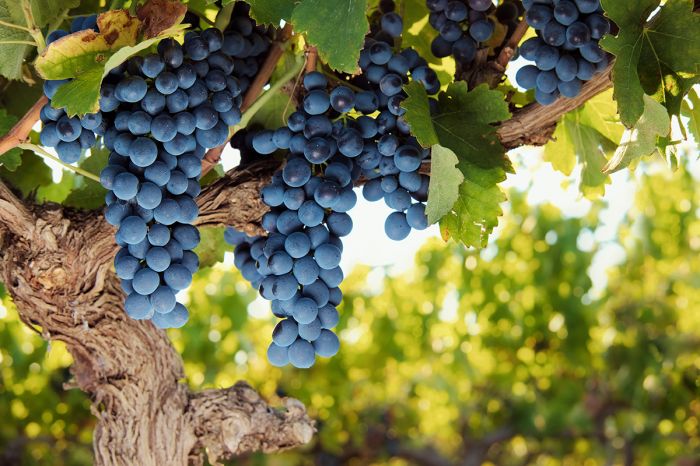
Grapes on the vine in the Franschhoek Valley
Today Franschhoek is known for having many of the country's top-rated restaurants and has become known as the "food and wine capital" of South Africa.
Accommodations are abundant and mostly upscale, with dozens of high-quality guesthouses and small cottages in town and on the surrounding wine estates. Finding accommodation during the summer is nearly impossible unless you book well in advance.
Besides the seemingly endless number of culinary and wine tasting choices, one can visit the Huguenot Memorial Museum and Huguenot Monument; both are definitely worth seeing.
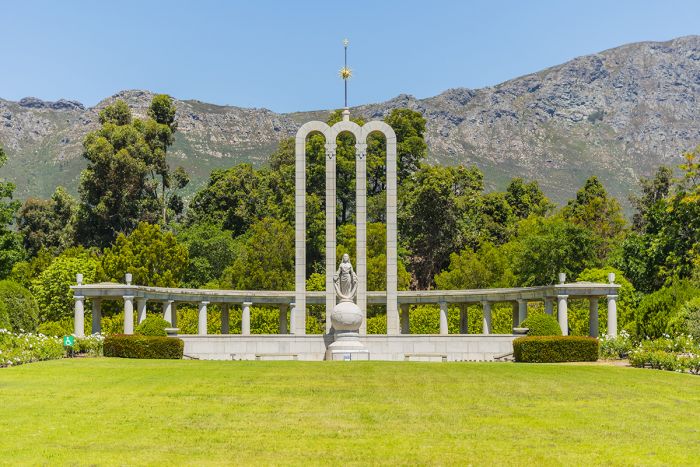
The Huguenot Monument in Franschhoek, South Africa
Our Winery Picks - Franschhoek
- Boschendal: Gorgeous old estate started in late 1600s. Wonderful tastings, cellar and estate tours. Country-style restaurant and picnics. Try the Blanc de Noir.
- L'Ormarins: State-of-the-art cellars and tasting rooms with five labels. High-tea (reservation only), antipasto bar, innovative and delicious wines.
- Haute Cabrière: Built into the side of mountain. Known for Cap Classique sparkling wines and fruity pinot noirs. Cellar tours and restaurant.
- La Motte: Lots to do; tastings, wine-pairing lunches and dinners, high-tea, tours, hiking trails and art gallery. Superb reds.
- La Petite Ferme: Small winery with wines produced only for its superb restaurant and overnight guests. Tastings by appointment only.
- Leopard's Leap: Casual atmosphere with tastings in a barn-style building. Lunch restaurant. Very family-friendly.
- Mont Rochelle: Spectacular views over the valley. Cellar tours, tastings, picnics. Two restaurants. Owned by Richard Branson.
- Plaisir de Merle: Huge estate with modern architecture. Tasting/food pairing and cellar tours. Excellent chardonnay and red blend.
- Solms-Delta: Uses an Ancient Greek wine-making technique to produce superb wines. Tastings, gardens, excellent restaurant, picnics and a museum.
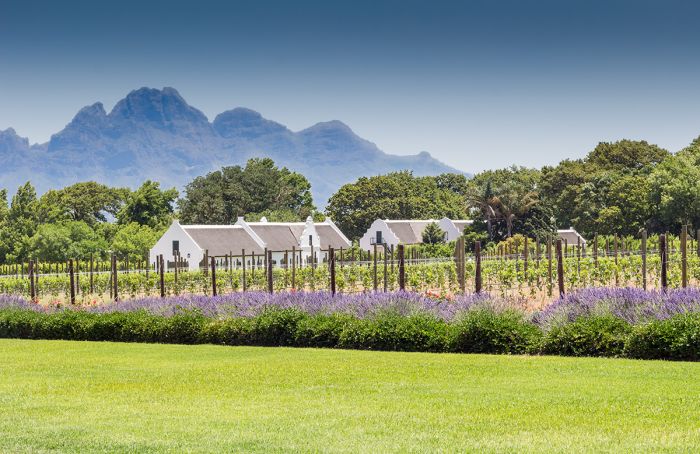
Young vines and lavender growing at La Motte Estate near Franschhoek
Paarl / WELLINGTON
Paarl is the largest town in the region, but is often overlooked by visitors heading for the Winelands. Paarl (Dutch for 'Pearl') is named for the silvery, granite-domed mountain just west of town.
The town of Wellington is a de facto urban extension of Paarl.
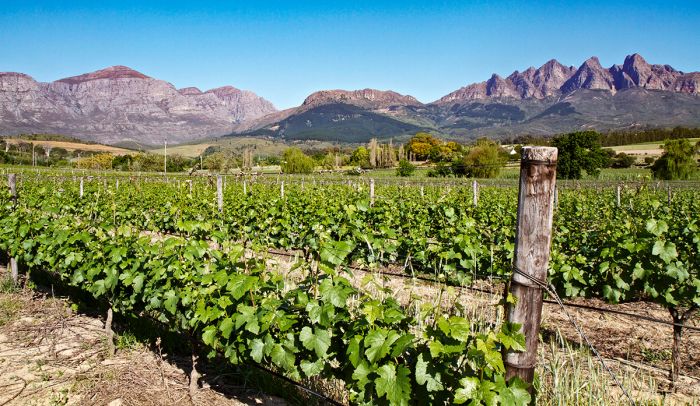
Paarl vineyard and mountains
The first farms started here in 1687 and the town itself was founded in 1720. Paarl lacks some of the attraction of Stellenbosch and Franschhoek, mostly because it's so spread out, but it offers some attractive historic Cape Dutch architecture on the 11-km-lomg, oak-tree-lined Main Street, which runs north-south through the center of town along the Berg river.
Paarl has a good range of accommodations and restaurants and the Paarl Museum is worth a look. The Taal Monument, an apartheid-era memorial built in 1975 and located on the slopes of Paarl Mountain overlooking the town, commemorates the centenary of the Afrikaans language in South Africa.
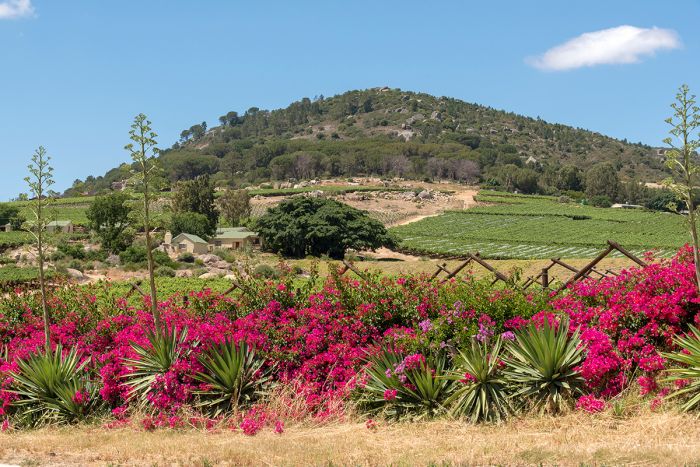
Vineyard, roadside flowers and Paarl Mountain
There are some excellent wines produced around Paarl and most of the estates have good-quality restaurants and some offer accommodations amidst their vineyards, which may be a more appealing option than staying in town.
Bain's Kloof Pass Road, opened in 1853, winds north out of Wellington through the Boland Mountains and offers spectacular views across the valley. On a clear day, one can see all the way west to the ocean coast. The road leads to Ceres and Worcester.
Noteworthy is the Groot Drakenstein (Victor Verster) Prison where Nelson Mandela spent his final years of incarceration. It was from here that he began his walk to freedom on February 11, 1990. No tours as the low-security prison is still used.
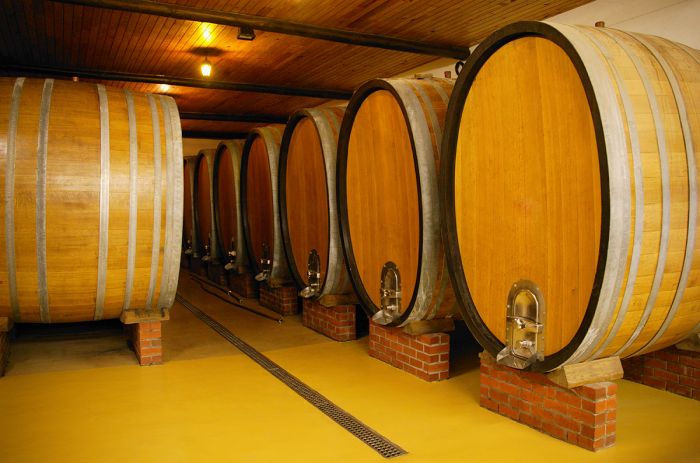
Cellar barrels in a Paarl wine estate
- Anura: Popular with foodies. Superb cheeses made on premises. Picnics offered. Micro-brewery. Wine specialties are Syrah and Malbec.
- Avondale: Homestead dates back to 1693 but only making wines since 1999. Organically made wines. Faber restaurant is one of the best.
- Babylonstoren: Very popular with a lovely setting beneath mountains. Extensive vineyards, gardens, olive trees. Two good restaurants and excellent wines.
- Backsberg: Beautiful setting, vineyards on mountain slopes. Extravagant outdoor lunches, Sunday lamb spit bbq, picnics. Restaurants and hedge maze.
- Fairview: Family-friendly. The resident goats are famous. Superb line of cheeses and wines. Excellent food at Goatshed restaurant. Popular Sunday lunch.
- Glen Carlou: Panoramic views and excellent wine, including chardonnay and red blends. Tastings and superb three-course meals. Zen fynbos garden.
- KWV: Historic cooperative that once controlled the Cape wine industry for decades. Enormous selection of brands and wines, plus Brandy. Tours of its vast cellars (covering 55 acres) are a highlight.
- Laborie: Located in town, spectacular manor, rose gardens, oaks and lawns. Tastings with views of Paarl Mountain. Excellent restaurant. Good wine and brandy.
- Nederberg: Locally loved label. Family friendly estate. Lovely restaurant open for lunch and a museum.
- Rhebokskloof: Picturesque setting, superb food, picnics, popular Sunday lunch buffet. Nice wines; shiraz the speciality.
- Spice Route: Owned by Charles Back (Backsberg). Excellent wines from bush vines. Artisan products include coffee, grappa, schnapps, beer. Tasty food.
- Wellington: Tasting room with marvelous views over the rolling vineyards. Superb wines at reasonable prices, especially the Shiraz-Mourvèdre blend.
Helshoogte Pass
One of the most scenic and beloved stretches of road in the country is the Helshoogte ('Hell's Heights') Pass. This 9-mile (15-km) section of the R310 is a winding mountain pass that connects Stellenbosch with the Banhoek Valley leading into Franschhoek. The views are fabulous and some of the region's top wine farms are located along the way.
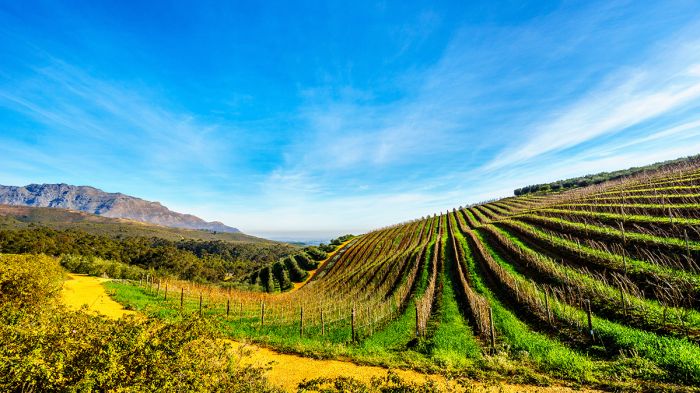
Vineyards and olive groves along the Helshoogte Pass Road between Franschhoek and Stellenbosch
The pass was originally built in 1854 and regardless of what else you do, this is a road worth driving to take in the vistas.
During the winter, the surrounding mountain peaks will likely have snow and in the summer, the views of the verdant valley or fruit trees and vineyards is breathtaking.
South African Wines
The South African wine industry is booming and the country is a significant player on the global market, but this wasn't always the case. Due to sanctions imposed on South Africa by the international community during the apartheid years, much of the wine produced in South Africa was consumed locally during this time. This all changed when apartheid ended and the industry experienced huge growth starting in the 1990s.
South African wines have historically had a reputation for good quality at the lower end of the market, but this too is changing, with more ultra-premium wines being produced every vintage. Overall, the wines of South Africa are very affordable and deliver excellent value for their price.
In terms of wine production, South Africa ranks ninth among the largest wine-producing countries in the world at 824 million liters per year. To put this in perspective, Italy is ranked 1st (5.48 billion liters), France is 2nd (4.91 billion liters), and the USA is 4th (2.39 billion liters).
In terms of wine exports, South Africa ranks 6th in the world at 420 million liters (this is 51% of the country's total production).
Global statistics above (for the year 2018) provided by the Paris-based International Organization of Vine and Wine (OIV).
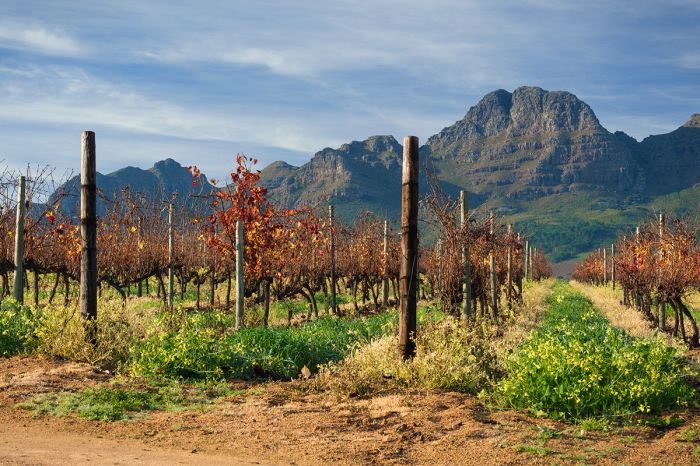
Stellenbosch vineyard and mountains
South Africa has 542 wineries, of which 213 are registered for 'Estate Wine' production, and 47 are co-operatives. Total farms growing wine grapes are numbered at 2 873.
In terms of regional wine production, Stellenbosch (which includes Franschhoek Valley wines) and Paarl are the country's biggest producers, as follows:
- Stellenbosch (incl. Franschhoek): 15 062 hectares (58 sq miles/150 sq kms) under vine, 168 private cellars, 2 co-operative cellars
- Paarl: 14 766 hectares (57 sq miles/148 sq kms) under vine, 109 private cellars, 6 co-operative cellars
- Swartland: 12 850 hectares, 28 private cellars, 2 co-operative cellars
- Robertson (Breede River Valley): 12 790 hectares, 37 private cellars, 9 co-operative cellars
- Breedekloof (Breede River Valley): 12 604 hectares, 17 private cellars, 11 co-operative cellars
- Olifants River: 9 694 hectares, 12 private cellars, 3 co-operative cellars
- Worcester (Breede River Valley): 6 505 hectares, 12 private cellars, 8 co-operative cellars
- Northern Cape: 3 851 hectares, 11 private cellars, 2 co-operative cellars
- Cape South Coast: 2 632 hectares, 55 private cellars, 0 co-operative cellars
- Klein Karoo: 2 266 hectares, 19 private cellars, 4 co-operative cellars
In terms of grape varietals, South Africa's production is 55% white wines and 45% red wines, broken down as follows:
- White Wines 55%: Chenin Blanc 18%, Colombar(d) 12%, Sauvignon Blanc 10%, Chardonnay 7%, Muscat d’Alexandrie 2%, Semillon: 1%
- Red Wines 45%: Cabernet Sauvignon 11%, Shiraz 10%, Pinotage 7%, Merlot 6%, Ruby Cabernet 2%, Cinsaut 2%, Pinot Noir: 1%
South Africa statistics above (for the year 2018) provided by SA Wine Industry Information & Systems (SAWIS) of Paarl.
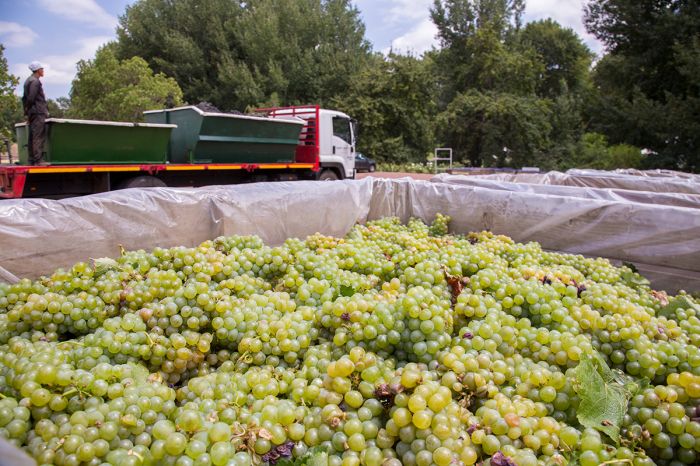
Freshly picked wine grapes in Stellenbosch, South Africa
Read More...
Cape Winelands, Franschhoek, Helshoogte Pass, Paarl, South African Wines, Stellenbosch, Wellington, Wineries-Franschhoek, Wineries-Paarl, Wineries-Stellenbosch
Great Good Fair Poor
- Jan
- Feb
- Mar
- Apr
- May
- Jun
- Jul
- Aug
- Sep
- Oct
- Nov
- Dec
The Cape Winelands are a year-round destination and there is no best time to visit... each season is special in its own way. Typically tourists combine the Winelands with Cape Town and/or the Garden Route, so checking our pages for those destinations may help you decide.
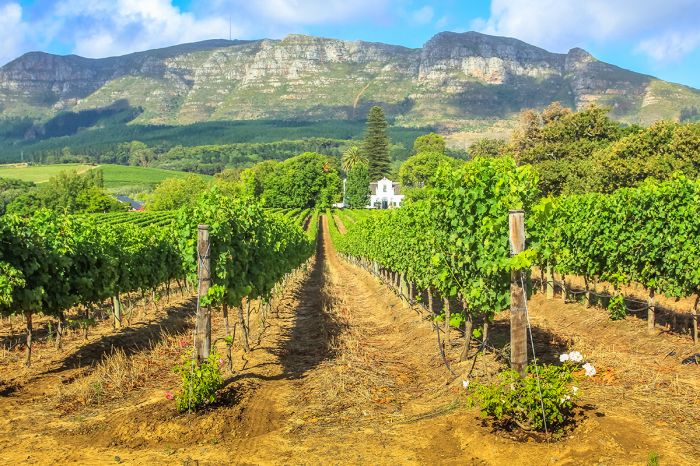
A Stellenbosch vineyard in full bloom with Thelema Mountain
Summer in the Winelands is December thru February and the days are long, hot and dry. Wine grapes are ripening on the vines and wine estate visits are wonderful at this time of year. Wine tasting, picnics and walks through the vineyards are a must do. Weekends can be crowded with locals visiting the wineries, so book restaurants and wine tours ahead of time. Daytime temps average around 68°F (20°C) and rains are uncommon but possible.
The autumn months of March thru May are also lovely in the Winelands. The colors change from green to orange and red and the landscape transforms. Grape harvesting and pressing is underway and the vineyards and wineries are bustling with activity. The days are shorter and cooler and the nights are very pleasant. Daytime temps average 57°F (14°C). Rainfall increases beginning mid-April and May receives 4-5 inches for the month.
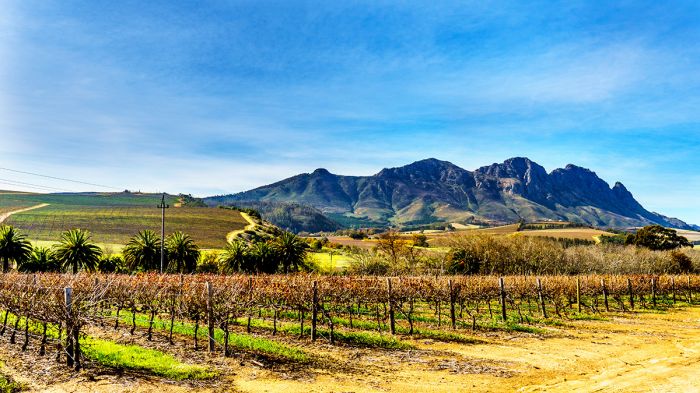
A Stellenbosch vineyard on a sunny winter day
The winter months (June thru August) are chilly and experience the majority of the annual rain. The vineyards are resting in anticipation of the coming spring. The wine estates are not busy and reservations for dinners at the amazing restaurants are easier to obtain. Sit by the fire and enjoy a glass of hearty red wine with your meal. Daytime temps average 54°F (12°C) and average monthly rainfall is 4-5 inches.
Springtime (September thru November) in the Winelands is spectacular. The vineyards explode back into life, with flowers and budding vines everywhere you look. The days are warming and winery workers are busy tending to the vines. Daytime temps are gradually increasing from around 57°F (14°C) in September to around 65°F (18°C) in November. Rainfall declines drastically, with around 2.5 inches in September to 1.4 inches in November.
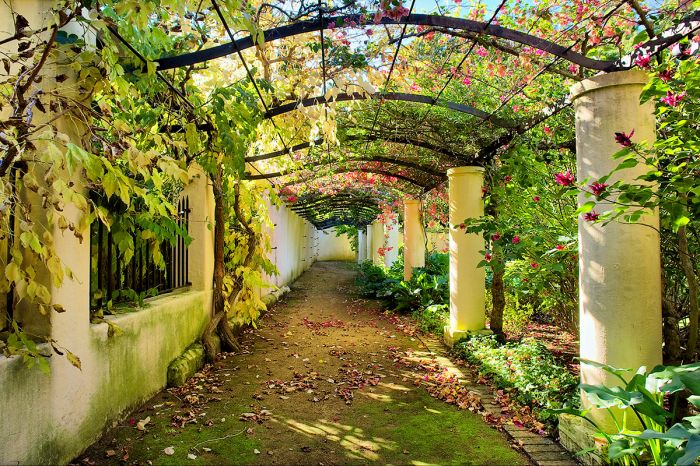
An autumnal floral arch at Vergelegen Estate




